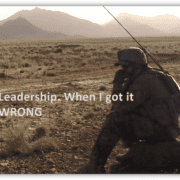Adults make over 35,000 decisions each day. Many of the choices you make are automatic and proceed without much conscious consideration, such as getting out of bed or the route you take to the office. Other decisions carry more weight and require additional time and thought before making a judgment. But what about making decisions at work? Do you have a decision-making method to determine the right course of action?
Most of us have never been formally coached on how to make important decisions. If you’ve had difficulty making decisions at work, or if the calls you’ve been making are resulting in undesired outcomes, there might be something wrong. Not necessarily with the decisions themselves, but with how you are making them.
What if you took a more methodical approach to decision-making? Decision-making methods do exist. In fact, the military wouldn’t be able to function without a system for making rational decisions we call the FASD method. Could implementing a similar decision-making method at work help you develop and hone your decision-making skills?
What Is the FASD Decision-Making Method?
The FASD approach is a military decision-making method that provides a framework for making informed decisions. This method guides choice-making with a systematic approach. To use this method for making decisions at work, you first determine the possible courses of action. Next, measure each of the options against the four FASD principles:
-
Feasibility
-
Acceptability
-
Sustainability
-
Discernibility
Both the Australian and American military use a variation of these terms in their decision-making methods. Let’s cover each one.
Feasible
Is the course of action feasible? Meaning can it be done within any restrictions you may have, including physical limitations, access to resources, and so on? Consider the amount of time required, the location, and the manpower needed.
For a simple example, let’s say your company’s fax machine has broken, and you are trying to choose whether to repair it or replace it. Is one option more financially feasible than the other? Do you have the staffing capacity to spend time comparing and testing new models? What about physical space–would a new machine take up more room, and can dedicate the square footage to this piece of equipment?
If it passes the feasibility test, you can move on to the next parameter.
Acceptable
Take the time to do a risk assessment. If a given option plays out as you expect it to, what are the consequences? Define the risks and determine if they are more detrimental than doing nothing. Balance the cost of this choice, which includes the risk involved in relation to the potential gain.
Continuing with the broken fax machine example, are the consequences of replacing vs. repairing the fax machine acceptable? If you replace it, the cost will be more significant, but repairing it may only buy time until another breakdown. Which option is more acceptable to you?
Sustainable (or Suitable)
In other words, are you capable of following through with this decision and maintaining the outcome on a long-term basis? Also, take a look at suitability — does the end result effectively resolve the problem you set out to solve with this decision-making method?
Referring back to our example, will the company be able to absorb the cost of replacing the fax machine, or will it do irreparable harm to the budget? Or, if you repair it, how long will it last until it breaks down again, thus incurring another cost?
Discernible
Lastly, look at whether each course of action is discernible. If the options you have identified at the beginning are not significantly different from each other, then you aren’t really making a decision — or rather, you’ve already made the decision, and who knows if it was the right one? If this is the case, return to the beginning of the process and redefine your potential courses of action, making sure each one solves the initial problem through a distinct and differing result.
In this case, our example problem of replacing vs. repairing broken equipment might have the same outcome if all other factors, such as cost and downtime, are the same. If that’s the situation, you should consider what problem you are really trying to solve. Is your end goal to send faxes? Or is it simply that you need a secure way of sending documents to clients? Are there other ways of accomplishing that goal other than a fax machine? Can you pivot to electronic signatures via an online platform or email? Or would you benefit from in-person meetings to go over these documents? Now, instead of tying yourself to a “choice” where you ultimately up in the same place no matter which option you choose (still using a fax machine), you have three truly unique options to choose from (fax machine, electronic sending, or in-person meetings).
From there, you can take the options that have passed the FASD criteria and conduct a course of action analysis to make a better and more informed decision at work.
Why the FASD Method Is Better Than Most Decision-Making Methods
The FASD decision-making method gives decision-makers the steps to complete a thorough assessment and review before making critical calls. This approach to decision-making is better than most others for various reasons. To understand this, let’s take a quick look at some other common ways decisions are made.
Common Alternatives to the FASD Decision-Making Method
Some of the common decision-making methods used to make decisions at work today include:
-
Commanding: Making decisions on your own without outside input
-
Consulting: Considering input from a small group of peers to make a decision
-
Voting: A group consensus where the majority rules
Each of the above methods fails to include one crucial step that the FASD masters: setting up the game properly. To make truly informed decisions as a leader in business, you first need to develop feasible options to compare. Each option has to be able to stand on its own merit and be entirely different (not just a slight deviation from the same plan).
The FASD method ensures that you’re choosing from the right set of choices. Assessing each course of action against the four principles above provides clarity in two ways. First, it acts as screening criteria to ensure each option is thoroughly considered. This prevents proceeding with a decision that fails to meet one of the FASD principles. Second, it enhances problem-solving abilities by requiring a thorough understanding of the situation before making any rash decisions to solve the problem.
When you adopt the FASD decision-making method, you can find your true power as a leader by adopting a military-like approach to your business. Doing a thorough review of your options before you choose one removes subjectivity and impulsive conclusions from your process, thereby earning you more respect from your team.
Take Your Decision-Making Method to the Next Level
Learning the right methods for how to make decisions at work can be a daunting task. If you feel this way, you are not alone. Luckily, there is help. At The Eighth Mile Consulting, our goal is to work with good people looking to improve themselves as employers and leaders.
If you’re looking for lessons that will take your leadership to the next level, take a look at our 8-week online leadership course to see if it might help you make better decisions at work and become a better leader for your team.



 The Eighth Mile Consulting
The Eighth Mile Consulting  The Eighth Mile Consulting
The Eighth Mile Consulting 
 The Eighth Mile Consulting
The Eighth Mile Consulting  The Eighth Mile Consulting
The Eighth Mile Consulting 
Trackbacks & Pingbacks
[…] have the metrics and the mindfulness to actively choose to make or remake operational decisions. You’re looking at your processes, policies, and methods and asking yourself, “How can […]
[…] before reacting negatively. This will help them stay calm under pressure and make the best decision for their […]
Leave a Reply
Want to join the discussion?Feel free to contribute!